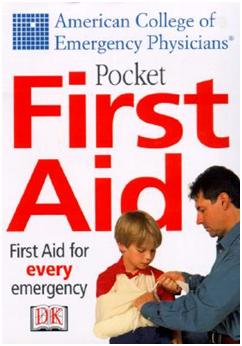 This book is the second choice I made for a go pack library. Small in stature, but packed with a wealth of information. Well worth the $7.00 I paid for it at a local bookstore.
This book is the second choice I made for a go pack library. Small in stature, but packed with a wealth of information. Well worth the $7.00 I paid for it at a local bookstore.
The book is primarily a pocket sized version of the American College of Emergency Physicians larger version, the complete first aid book, if you will. At 128 pages long and small enough to slip into your pants pocket it will fit very nicely into most first aid kits or a easy access pocket on your own go packs. The illustrations are actual photographs of various procedures and steps, which I found refreshing after pouring through pages and pages of crudely done line drawings that didn’t show things as clearly as this little gem of a book does.
Divided into nine sections, you can easily find a chapter for whatever types of medical emergency you may encounter.
Section 1, Techniques and Equipment talks about some of the basic medical supplies you should have and how to use them. It also goes into the way you should apply bandages and slings, which will be some of the more common things you may have to address in the moments after an accident. Especially if blood is present.
Section 2,Life Saving Procedures, addresses various ways to deal with resuscitation of a victim, life saving priorities and choking incidents. There are some interesting flow charts that take you step by step through some of the situations. It even includes a chart on the usage of a portable defibrillator. Not that we all carry one in our first aid kit, but it’s good information to have available. Many businesses now keep and emergency defibrillator on hand for just such emergencies. The prices keep coming down as the technology and demand for the units increase, so I would expect there to be a growing availability of these units as time goes by.
Section 3, Circulatory and Respiratory Problems deals with things like shock, heart attacks and problems, fainting, asthma, drowning and penetrating wounds to the chest. In a disaster, any one of these situation can come upon a member of your party with absolutely no prior warning, so it is important to familiarize yourself with this information. One of the points you should keep in mind that when it comes to heart problems, giving the victim a 325mg aspirin helps to thin the blood and may be the key a rapid recovery, or at the very least provide the victim some time until professional help and an ambulance arrives. Make sure you keep a small bottle in your medical kits, and keep the date current on the bottle.
Section 4 deals with Wounds and Bleeding, and covers everything from a simple nosebleed up to severe bleeding. A couple of points to remember here is that wounds should be cleaned with clean running water or a non-alcohol cleaning wipe. Objects that may have become embedded in the wound may need to be removed as well, to prevent infection and further irritation.
Bone, Joint, and Muscle injuries are covered in section 5. This is a head to toe look at possible bone injuries, as well as muscular sprains and other problems related to the two. The first couple of pages describe some of the different types of fractures as well as muscle, tendon, and ligament injuries. The section also goes into some splinting procedures.
Section 6 goes into Disorders of Consciousness. These disorders deal with concussion, cerebral compression, skull fractures for starters. The section also covers hypo- and hyperglycemia, various seizures, strokes and diabetes.
Environmental Injuries are covered in section 7. These include incidents such as burns and scalding, electrical and chemical burns, heatstroke and exhaustion and cold related emergencies such as frostbite and hypothermia.
Section 8 considers Foreign Objects, such as splinters and fishhooks, inhaled and swallowed objects, and things that get stuck in your eye, ear and nose. Probably should be a must read section if you have little ones along, from what I have heard about the kiddies.
Lastly, section 9 deals with Poisoning, Bites and Stings. It’s amazing at how many things exist in this world that can harm you, especially from unseen sources, such as little bugs and the neighbor’s dog. Like the rest of the book, this section also covers a great deal in a small space, and is also important info you need. As a bonus, I would suggest you photocopy the last page of the book, make several copies and have them on hand in your medical kit for emergencies. It will help you through the incident and provide some much needed information to any first responders that may be called.
The ISBN for this book is 978-0-7894-9265-4 and can be purchased at leading booksellers. Many will have them in stock in their medical section, and can also be ordered from many sources as well. I find it to be a great companion book to the Collins Gem version of the SAS Pocket Survival Guide, and I keep both of them in my go-pack or bug out bag. Pick up a copy and read it thoroughly. Just remember that this book, or any other book for that matter is no substitute for proper first aid training. I would also recommend that you get a full featured first aid manual as well, just to have an even greater collection of knowledge on hand.
No comments:
Post a Comment